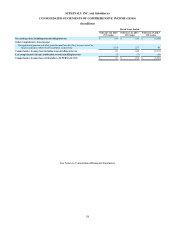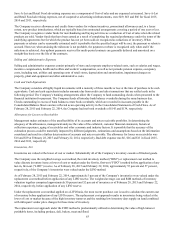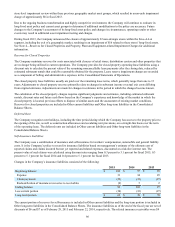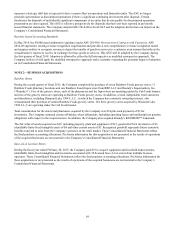Albertsons 2015 Annual Report Download - page 69
Download and view the complete annual report
Please find page 69 of the 2015 Albertsons annual report below. You can navigate through the pages in the report by either clicking on the pages listed below, or by using the keyword search tool below to find specific information within the annual report.67
and $18 as of February 28, 2015 and February 22, 2014, respectively. The current portion of the insurance receivables is
included in Receivables, net and the long-term portion is included in Other assets in the Consolidated Balance Sheets.
Benefit Plans
The Company recognizes the funded status of its Company-sponsored defined benefit plans in its Consolidated Balance Sheets
and gains or losses and prior service costs or credits not yet recognized as a component of Other comprehensive income (loss),
net of tax, in the Consolidated Statements of Stockholders’ (Deficit) Equity. The Company sponsors pension and other
postretirement plans in various forms covering substantially all employees who meet eligibility requirements. The
determination of the Company’s obligation and related expense for Company-sponsored pension and other postretirement
benefits is dependent, in part, on management’s selection of certain actuarial assumptions in calculating these amounts. These
assumptions include, among other things, the discount rate, the expected long-term rate of return on plan assets and the rates of
increase in compensation and healthcare costs. These assumptions are disclosed in Note 11—Benefit Plans. Actual results that
differ from the assumptions are accumulated and amortized over future periods in accordance with generally accepted
accounting standards.
The Company contributes to various multiemployer pension plans under collective bargaining agreements, primarily defined
benefit pension plans. Pension expense for these plans is recognized as contributions are funded. See Note 11—Benefit Plans
for additional information on the Company’s participation in multiemployer plans.
The Company also contributes to several employee 401(k) retirement savings plans.
Derivatives
The Company uses derivatives only to manage well-defined risks. The Company does not use financial instruments or
derivatives for any trading or other speculative purposes.
Interest rate swap contracts are entered into to mitigate the Company's exposure to changes in market interest rates. These
contracts are reviewed for hedging effectiveness at hedge inception and on an ongoing basis. If these contracts are designated
as a cash flow hedge and are determined to be highly effective, changes in the fair value of these instruments are recognized in
Other comprehensive income (loss) in the Consolidated Statements of Comprehensive Income (Loss). Hedging ineffectiveness,
if any, is recognized in earnings in the Consolidated Statements of Operations.
The Company’s limited involvement with diesel fuel derivatives is primarily to manage its exposure to changes in energy prices
utilized in the shipping process. These contracts are economic hedges of price risk and are not designated or accounted for as
hedging instruments for accounting purposes. Changes in the fair value of these instruments are recognized in earnings in the
Consolidated Statements of Operations.
In addition, Company enters into energy commitments for certain electricity and natural gas purchases that it expects to utilize
in the normal course of business. Changes in these purchase obligations are not recognized in earnings until the underlying
commitment is utilized in the normal course of business.
Stock-Based Compensation
The Company uses the straight-line method to recognize stock-based compensation expense over the requisite service period
related to each award. Stock-based compensation expense is measured by the fair value of the award on the date of grant, net of
the estimated forfeiture rate.
The fair value of stock options is estimated as of the date of grant using the Black-Scholes option pricing model using Level 3
inputs. The estimation of the fair value of stock options incorporates certain assumptions, such as the risk-free interest rate and
expected volatility, dividend yield and life of options. Restricted stock awards and units are recorded as stock-based
compensation expense over the requisite service period based on the market value of the Company's common stock on the date
of grant.
Income Taxes
Deferred income taxes represent future net tax effects resulting from temporary differences between the financial statement
amounts and tax bases of assets and liabilities and are measured using enacted tax rates in effect for the year in which the
differences are expected to be settled or realized. See Note 9—Income Taxes for the types of differences that give rise to
significant portions of deferred income tax assets and liabilities. Deferred income tax assets are reported as a current or
noncurrent asset or liability based on the classification of the related asset or liability or according to the expected date of
reversal.
























